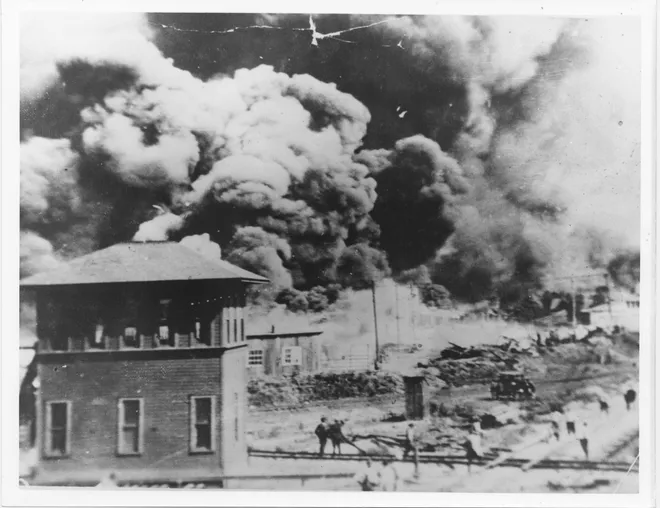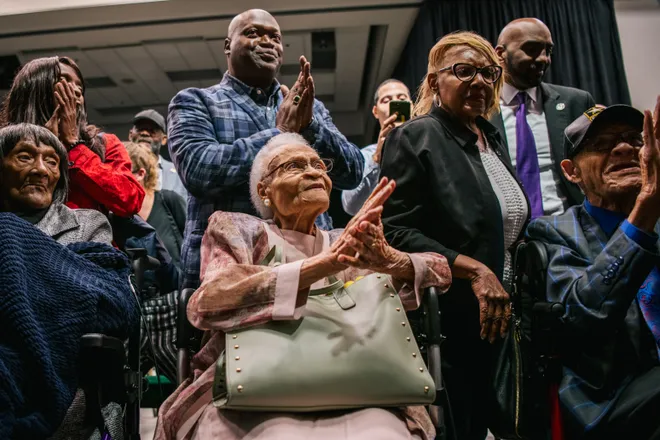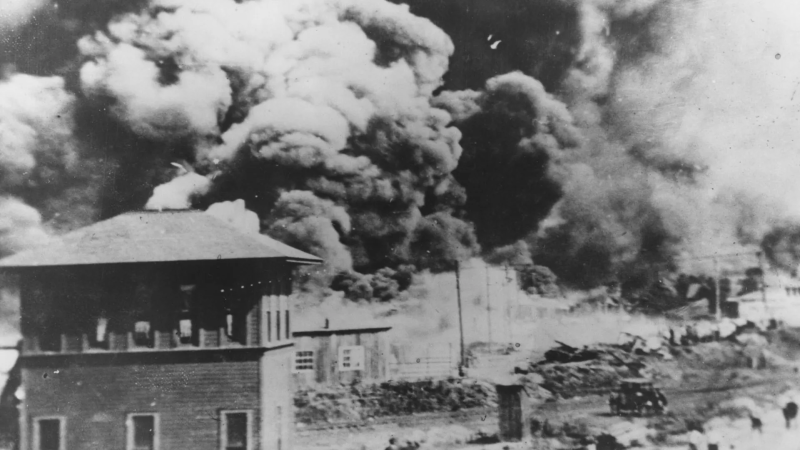Tulsa Race Massacre survivors seek justice as search for graves, family roots continue
The survivors of the 1921 Tulsa Race Massacre, which is considered one of the most heinous acts of racial violence in U.S. history, can vividly remember when a white mob destroyed the robust all-Black Greenwood District in Tulsa, Oklahoma.
Decades later, neither Viola Fletcher nor fellow survivor Lessie Benningfield Randle have been compensated for the harrowing experience. It has been estimated that hundreds of "Black Wall Street" residents were killed during the attack, and homes and businesses were annihilated on May 31, 1921, and June 1.

Since the massacre, archivists, attorneys, archeologists, and historians have rallied around the survivors to help them tell their stories. While learning about the massacre, some people have learned that they, too, are connected to a victim or are descendants of a victim.
Tulsa native, Africa diaspora archaeologist National Geographic explorer Dr. Alicia Odewale described Greenwood as a "space of refuge and safety." In recent years, she has discovered her family's ties to the massacre, and in her work, she uses archaeology to learn more about Greenwood.
Greenwood "is a space where the community came together despite the racial terror that was all around them," she told USA TODAY.
"It's more important for us to keep talking about Greenwood, to keep talking about this community that still exists, that nevertheless, that is continuing to fight this continual fight for justice for the survivors and their descendants," she said. "We have to continue to hold our legislators accountable and ensure our history is being taught."
Coming home to ‘nothing left':An illustrated history of the Tulsa Race Massacre.
'Mother Fletcher' and 'Mother Randle' are the last living survivors

At 110, "Mother Fletcher," a mother and grandmother, is notably the oldest survivor of the Tulsa Race Massacre. She has launched the Viola Ford Fletcher Foundation, a non-profit that aims to help individuals' "self-sufficiency through health, educational knowledge-sharing and workforce opportunity," according to its website.
Last year, Fletcher and her grandson, Ike Howard, also released a memoir titled "Don't Let Them Bury My Story."
In May 2021, Fletcher, her brother Hughes Van Ellis nicknamed "Uncle Red" – a World War II veteran who recently passed away last year −and Randle appeared before Congress, pushing for their reparations and for the country to acknowledge the tragedy that impacted generations.
Dressed in a sage green blazer and sitting poised before lawmakers, Fletcher recounted the night of the massacre, describing herself as "rich."
"Not just in terms of wealth, but in culture, community, heritage, and my family had a beautiful home," she clarified. "We had great neighbors, and I had friends to play with. I felt safe. I had everything a child could need. I had a bright future ahead of me."
Fletcher went to sleep in her home but was awakened hours later as chaos ensued. She was only 7 years old at the time. The home she knew was gone, but the memories and violence she witnessed lived with her throughout her years.
"I still see Black men being shot, Black bodies lying in the street. I still smell smoke and see fire, I still see Black businesses being burned, I still hear airplanes flying overhead. I hear the screams," she explained. "I have lived through the massacre every day. "
In the meeting before Congress, Randle tells them how her grandmother's home was looted and destroyed before her eyes. As a result, she explained that what she saw still has an impact on her today causing emotional and physical distress. In her Oct. 14, 2020 deposition, Randle told Congress she experiences flashbacks from the Tulsa massacre and is taken back to the sight of Black bodies being stacked up on the street as her neighborhood was set on fire.
"Whenever we're talking about this story, I don't think people recognize that a lot of the survivors that have shared all their testimony were children at the time. This is a story about children," Odewale said.
'We're going to fight to the finish':Tulsa Race Massacre survivor on lawsuit and struggle
Search for graves of victims from Tulsa Race Massacre
The past three searches for graves from the Tulsa Race Massacre have uncovered 35 exhumed burials. Of those, eight supplied enough genetic information to determine family history, according to a May 29 update posted to the City of Tulsa's website.
The website also provides a full list of those burials, their surnames and location.
Intermountain Forensics, the laboratory helping the City of Tulsa with its search for victims and relatives from the Tulsa massacre, says it has identified many families but is still looking for more.
"All of us at Intermountain Forensics are both humbled and honored to contribute to such a pivotal initiative, which also serves as a template for addressing similar historical injustices nationwide,” Intermountain Forensics Director of Laboratory Development, Danny Hellwig, said in the press release. “The assistance from the public has been invaluable, and continued support of family stories and DNA comparisons will be crucial as we move forward in this historic work. We are pleased to report significant progress in our work on the 1921 Tulsa Graves Project.”
1921 Tulsa Race Massacre:2 dozen more unmarked graves discovered in search for victims
Tulsa Mayor G.T. Bynum said in the press release that the lab working to find and make these genetic profiles has helped the project move forward.
“I’m so thankful for our experts who have been pouring over the samples and data for the better part of the past year to help move this investigation forward,” Bynum said. “Six years ago, we wanted descendants and the community to have more answers and today we are one step closer on the identification side. I feel a great sense of responsibility to follow through on what we promised and I’m eager for the process to continue.”

Tulsa Massacre survivors lawsuit
Damario Solomon-Simmons, attorney at Solomon-Simmons Law in Tulsa, told USA TODAY that he was a young law student turned lawyer when he got involved in the Tulsa Race Massacre lawsuit.
“In 2004, I was very fortunate as a law student and then a young lawyer to work as a clerk and a young lawyer with Professor Charles Ogletree, Johnny Cochran, Willie Gary, Michelle Roberts," Solomon-Simmons said. "Some of the greatest civil rights attorneys across the nation that bought a federal case and that case lasted a couple years and that got dismissed in the federal reports."
Solomon-Simmons and his team started to do some research and stumbled upon the public nuisance theory.
“We worked on that for over a year, and we filed the case Sept. 1, 2020 as both a public nuisance case, which is saying that there is still remnants and problems that the massacre created back in 1921 is still ongoing. That's the key to a public nuisance case," Solomon-Simmons said. "It's ongoing and doesn't matter when it is like an oil spill, right? Oil spill comes in spilled out 1 million gallons of oil on June 1, 1921, and there's still some oil that are causing problems June 1, 2021."
The case isn’t just for his clients, it’s for the entire Greenwood community.
“It's not just for the individual clients, it is for the entire approximately 40 blocks of Greenwood that was devastated that is still suffering," Solomon-Simmons said. "Blight, that started because of the massacre, still suffering from other ongoing of what's called in the law, continuing harm."
Tulsa attorney forms a friendship with the massacre survivors
Solomon-Simmons said although Fletcher and Randle are his clients, he meets with them regularly. Fletcher turned 110 years old a few weeks ago and Solomon-Simmons attended her birthday party in Frisco, Texas at her grandson’s home. With Randle he is working on a mini documentary called “Greenwood is still burning” in a partnership with Lush Cosmetics that premiered on Friday May 31 in Tulsa.
“Lush they have a platform called Waterbury. The 205 different locations will have information about our litigation, about Justice for Greenwood and people can actually write a letter of support to us to the Department of Justice," Solomon-Simmons said. "They're gonna have that going on for two weeks. They've trained all of their managers at each store a little bit about the history, a little bit about lawsuit, and then you go in there, you can see, you'll see a silhouette of myself, Mother Randle and Cecil McBee and you can press the button, you can hear a little discussion from us."
Solomon-Simmons said that working with Fletcher and Randle has given him a different perspective on life. Fletcher’s parents were sharecroppers and Randle’s grandmother was an enslaved African, Solomon-Simmons said.
“Despite all of that discrimination, world wars, two pandemics, Jim Crow. They're still optimistic," he said. "They're still hoping that the city and the court system will do the right thing.”
While testifying alongside Hughes Van Ellis in the United States House of Representatives on May 19, 2021, Solomon-Simmons said he told him something that has stuck with him until this day.
“One thing that Uncle Red said, that was just so powerful and sticks to my mind, he said, “you know, we're not just pictures on a black and white photo, we're real flesh and blood.”
Taylor Ardrey is a Trending news reporter for USA TODAY. Reach her at TArdrey@gannett.com.
Ahjané Forbes is a reporter on the National Trending Team at USA TODAY. Ahjané covers breaking news, car recalls, crime, health, lottery and public policy stories. Email her at aforbes@gannett.com. Follow her on Instagram, Threads and X (Twitter).
Disclaimer: The copyright of this article belongs to the original author. Reposting this article is solely for the purpose of information dissemination and does not constitute any investment advice. If there is any infringement, please contact us immediately. We will make corrections or deletions as necessary. Thank you.





